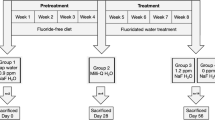Abstract
To elucidate compositional changes of the pineal body with aging, the authors investigated age-related changes of elements in the pineal body. After the ordinary dissection by medical students was finished, the pineal bodies and seven arteries were resected from the subjects ranging in age from 58 to 94 years. The element contents were determined by inductively coupled plasma atomic emission spectrometry. It was found that a high accumulation of Ca and P occurred in the pineal bodies with aging. Regarding the relationships among the elements, it was found that there were significant direct correlations among the contents of Ca, P, and Mg. With regard to the relationships between the pineal body and the arteries, no significant correlations were found in the Ca content between the pineal body and the arteries, such as the thoracic and abdominal aortas and the coronary, common carotid, pulmonary, splenic, and common iliac arteries.



Similar content being viewed by others
References
Okudera H, Hara H, Kobayashi S et al (1986) Evaluation of the intracranial calcification associated with aging on computerized tomography. No To Shinkei 38:129–133
Winkler P, Helmke K (1987) Age-related incidence of pineal gland calcification in children: a roentgenological study of 1,044 skull films and a review of the literature. J Pineal Res 4:247–252
Kwak R, Takeuchi F, Ito S et al (1988) Intracranial physiological calcification on computed tomography (part 1): calcification of pineal region. No To Shinkei 40:569–574
Schmid HA, Requintina PJ, Oxenkrug GF et al (1994) Calcium, calcification, and melatonin biosynthesis in the human pineal gland: a postmortem study into age-related factors. J Pineal Res 16:178–183
Sandyk R (1994) The relationship of pineal calcification to cerebral atrophy on CT scan in multiple sclerosis. Int J Neurosci 76:71–79
Schmid HA, Raykhtsaum G (1995) Age-related differences in the structure of human pineal calcium deposits: results of transmission electron microscopy and mineralographic microanalysis. J Pineal Res 18:12–20
Arai Y, Yoshihara S, Iinuma K (1995) Brain CT studies in 26 cases of aged patients with Down syndrome. No To Hattatsu 27:17–22
Humbert W, Pevet P (1995) Calcium concretions in the pineal gland of aged rats: an ultrastructural and microanalytical study of their biogenesis. Cell Tissue Res 279:565–573
Humbert W, Cuisinier F, Voegel J-C et al (1997) A possible role of collagen fibrils in the process of calcification observed in the capsule of the pineal gland in aging rats. Cell Tissue Res 288:435–439
Swietoslawski J (1999) The age-related quantitative ultrastructural changes in pinealocytes of gerbils. Neuroendocrinol Lett 20:391–396
Tohno Y, Tohno S, Minami T et al (1996) Age-related changes of mineral contents in human thoracic aorta and in the cerebral artery. Biol Trace Elem Res 54:23–31
Pelham RW, Vaughan GM, Sandock KL et al (1973) Twenty-four hour cycle of a melatonin-like substance in the plasma of human males. J Clin Endocrinol Metab 37:341a–344a
Commentz JC, Fischer P, Stegner H et al (1986) Pineal calcification does not affect melatonin production. J Neural Transm Suppl 21:481–502
Mori R, Kodaka T, Sano T (2003) Preliminary report on the correlations among pineal concretions, prostatic calculi and age in human adult males. Anat Sci Int 78:181–184
Tohno Y, Tohno S, Moriwake Y et al (2001) Accumulation of calcium and phosphorus accompanied by increase of magnesium and decrease of sulfur in human arteries. Biol Trace Elem Res 82:9–19
Tohno S, Tohno Y, Moriwake Y et al (2001) Quantitative changes of calcium, phosphorus, and magnesium in common iliac arteries with aging. Biol Trace Elem Res 84:57–66
Acknowledgment
Portions of this work were supported by a Grant-in-Aid for Scientific Research no. 17200032 from Japan Society for Promotion of Science.
Author information
Authors and Affiliations
Corresponding author
Rights and permissions
About this article
Cite this article
Ongkana, N., Zhao, Xz., Tohno, S. et al. High Accumulation of Calcium and Phosphorus in the Pineal Bodies with Aging. Biol Trace Elem Res 119, 120–127 (2007). https://doi.org/10.1007/s12011-007-0054-4
Received:
Accepted:
Published:
Issue Date:
DOI: https://doi.org/10.1007/s12011-007-0054-4




